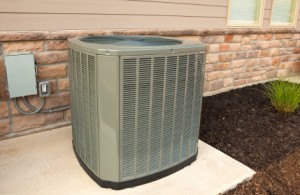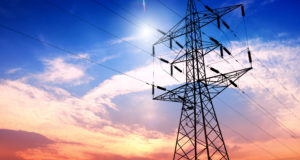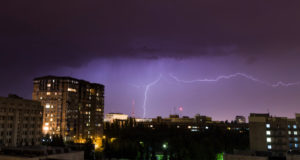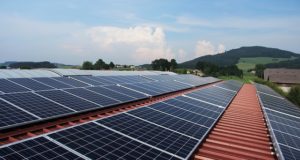 There are a lot of unique and interesting ways for inventive and imaginative folks to heat and cool their off-the-grid homes. One method that is beginning to make a bigger splash is the heat pump, which works by transporting heat from one location to another, most commonly from outside to inside. When in operation, these electrical devices can remove latent heat from either the air or the ground during the colder months and distribute it through a system of ducts to the rooms of an adjacent home, keeping inside spaces toasty and warm when the temperatures head south. But most heat pumps are also reversible, meaning that in summer time they can be used to suck the unwanted warm air right out of a home before releasing it into the atmosphere outside. Heat pumps are much more energy-efficient than furnaces or air conditioners because they do not consume power by directly heating or cooling the air; instead, they simply capture the heat that is already there and move it to a location where it will be able to do some good.
There are a lot of unique and interesting ways for inventive and imaginative folks to heat and cool their off-the-grid homes. One method that is beginning to make a bigger splash is the heat pump, which works by transporting heat from one location to another, most commonly from outside to inside. When in operation, these electrical devices can remove latent heat from either the air or the ground during the colder months and distribute it through a system of ducts to the rooms of an adjacent home, keeping inside spaces toasty and warm when the temperatures head south. But most heat pumps are also reversible, meaning that in summer time they can be used to suck the unwanted warm air right out of a home before releasing it into the atmosphere outside. Heat pumps are much more energy-efficient than furnaces or air conditioners because they do not consume power by directly heating or cooling the air; instead, they simply capture the heat that is already there and move it to a location where it will be able to do some good.
The two most common types of these devices are air-source and ground-source, or geothermal, heat pumps. Each has its advantages and disadvantages, but in this article we will be focusing strictly on air-source heat pumps.
Air-Source Heat Pumps 101: The Cliff’s Notes Version
We tend to think of cold air as being utterly bereft of warmth. But as long as air temperatures remains above absolute zero, there is in fact heat present, and heat pumps are constructed to harvest this hidden warmth and redistribute it to the interiors of homes or other indoor spaces.
Air-source heat pumps are generally divided into two sections, one of which will be located on the exterior of a house and the other just inside an interior wall. These electrically powered heat exchangers usually consist of the following parts:
- An exterior fan
- A network of refrigeration coils with an inner and outer grill
- A compressor
- An interior fan
- A reversing valve
Heat pumps work on the very same principles as refrigerators. The exterior fan pulls in air from outside, and as it passes across a grill of refrigeration coils, the air will transfer any heat it contains to the cold liquid refrigerant inside. This refrigerant is then pressurized and heated further by the compressor, and as it circulates through its network of coils, moving through the wall into the inside of the home, it releases all of its excess heat through an interior grill, just as a refrigerator does on its back side. But while a fridge only produces waste heat that is vented aimlessly into a wall, the refrigeration grill connected to a heat pump funnels the heat it produces into a powerful blower, which sends hot air out through a ductwork system that distributes it throughout the rest of the house. Meanwhile, after releasing its heat, the gaseous coolant in the coils returns to its previous liquid state before cycling back outside to the exterior refrigeration grill, where the whole process will start all over again.
And there you have it. The air-source heat pump is the prototypical example of the magic than can occur when simplicity is mixed with just the right amount of ingenuity. Now of course it is true, we are talking here about a system that needs an electrical input to function, and we all know how precious energy resources can be in an off-the-grid setting. But the beauty of the air-source heat pump is that for every unit of electricity it consumes, it will produce two to three times as many units of heat, which makes it one of the most efficient technologies for heating available in the marketplace. We should of course put the word “produce” in quotation marks in this case, because a heat pump only “produces” heat in the same way that a modern milking machine (or a farmer with cold hands who prefers doing things the old-fashioned way) “produces” the milk that comes out of the cow.
But in the case of the milk and the cow, the flow is only in one direction, and this is where the heat pump has the milking machine and the farmer beat by a country mile. For as we have already mentioned, a heat pump can be used to either warm or cool interior spaces; it is simply a matter of using the reversing valve to switch the direction of the fans so that the hot air from inside the home can be vented out. But whichever way the air-source heat pump is used, its high level of efficiency is preserved, and one of the huge advantages of a heat pump is that it only requires one significant investment to replicate the entire performance of a conventional HVAC system, which requires both the furnace and the air conditioner to function twelve months of the year.
The Limitations Of An Evolving Technology
There is one bit of bad news about standard air-source heat pumps, and that is that they start to lose efficiency once temperatures begin to approach freezing. This means the electricity they consume will give you a lot less bang for the buck when things get seriously frigid in the heart of the winter, and if temperatures where you live regularly fall below 32 degrees, the air-source heat pump will not be able to heat your home during the coldest months in a cost-effective manner. This does not necessarily mean a standard heat pump system would be a waste of money for you, however; it just means that you will need some sort of back-up source of heating to complement your heat pump should you choose to install one. Some heat pumps provide their own back-up heating source in the form of electric resistance coils, but these are electricity consumers of course, and they will not operate anywhere near as efficiently as the pump itself.
Because of its normal two- or three-to-one efficiency ratio, a conventional air-source heat pump could still pay off for you in a colder climate if you were using it frequently from March to November. Nevertheless, the cold weather limitations of the standard unit are something you will want to take into consideration before you invest the $1,000 to $4,000 that an air-source set-up will cost you.
Let’s remember, however, that we live in an age where energy efficiency and “going green” are all the rage. When you have a promising technology like that associated with the heat pump, which works with nature instead of battling against it, we would expect there to be a lot of well-funded research and development going on, and that is indeed the case. As a result, over the past few years there have been some tremendous strides made in the area of improved heat pump efficiency, and there are now some alternatives available to the conventional air-source unit that can partially or completely overcome cold weather limitations.
Harness the power of the sun for your energy needs…
Reverse Cycle Chillers
Right now, the most affordable and practical of these alternatives is the reverse cycle chiller (RCC). The RCC works by the same principles as the normal air-source heat pump, but while a regular model releases its heat directly into the home, an RCC transfers the heat it collects instead to a large, highly insulated water tank. The water heated in the tank is used to heat the surrounding air, which is then distributed throughout the home by a blower and a network of ducts and vents. Or, alternatively, the hot water can be circulated through the tubing of a radiant floor heating system, which is generally more economical than any kind of forced-air technology.
At first consideration, you might think that a more complicated system such as this that adds an extra step to the process would be less efficient. But the collected and transferred heat will ultimately end up doing exactly the same amount of work, and the physics of it all allows the reverse cycle chiller to operate at peak efficiency no matter how low the temperatures outside sink. With a properly sized RCC, you will not have to worry about providing a supplementary heat source to maintain efficient operations – if you want or need more heat than your unit can produce, then yes, you will need one, but back-up heat source or no, the reverse cycle chiller will still continue to produce excellent results in the most extreme northern climates on even the coldest January mornings.
The downside to the reverse cycle chiller is exactly what you might expect. It is indeed more pricey than a conventional air-source heat pump (about 25 percent more expensive at minimum), but the RCC will cover the cost of this additional expense in about two or three years time, simply because it is able to function so smoothly and consistently in all weather conditions.
Options, Considerations, And Cautions
Air-source heat pumps are rated according to two different standards: seasonal energy efficiency rating (SEER) and heating seasonal performance factor (HSPF). The former measures a unit’s overall cooling efficiency (how much energy it uses for each unit of cooling it produces, in other words), while the latter not only reflects a heat pump’s ability to provide warmth but also factors in supplemental heating needs.
For home use, units with SEER ratings of 14 to 18 (or around 12 for a reverse cycle chiller) and HSPF ratings in the 8 to 10 range are recommended. Even though the Energy Star system can be a bit inconsistent, in this instance the specifications an air-source heat pump must meet to receive this government-sponsored badge of honor are perfectly consistent with these standards. So if you just look for the Energy Star label when you go shopping for a heat pump, you should come out all right.
Since the compressor is the part of the air-source heat pump that consumes the most electricity, this is where you might want to invest a little bit more to get something of the high-end variety. Two good energy-efficiency enhancing possibilities here are dual-mode compressors and scroll compressors. The dual-mode type will adjust its speed and power up or down based on actual heating or cooling needs, so you won’t have to keep shutting the pump on or off if indoor temperatures become unpleasant. Scroll compressors are state-of-the-art devices that reduce noise, save energy, and last much longer than a traditional compressor, which makes them worth the extra cost and then some.
One negative aspect of air-source heat pumps is that when you have to make the change from cooling to heating mode during the fall or early winter, it will take some time for the interior grill to defrost, and as a result you can get a pretty sustained blast of cold air coming into the house when the unit is turned on. Heat pumps are generally sold with backup burners that can counteract this problem, but if you select a unit that does not include this feature, you had better be prepared to deal with this chilly inconvenience.
Maintenance of a heat pump is a relatively simple affair. Filters should be changed approximately every month, and it is necessary to frequently inspect every part of the system to ensure that nothing is plugging or clogging the fans, coils, or compressor. Some of the more vexing problems experienced by air-source heat pump owners include low airflow, refrigerant leaks, incorrect refrigerant charge, leaky ducts, motor or compressor malfunctions, and unexplained noises or rattling. In order to prevent such problems from occurring, a professional should be called in to inspect a heat pump set-up at least every two years, and while it might be possible for DIY enthusiasts to handle some repairs or troubleshooting, you will definitely need to bring in a pro if anything goes wrong with your coil system. The chemicals used in refrigeration are almost always toxic, and for that reason they are not something you should be fooling around with all on your own.
With proper care and proactive maintenance, a good air-source heat pump system could last from fifteen to twenty years, if not a little bit longer. Even though they do represent a fairly significant investment, a heat pump system can unquestionably pay for itself over time, and that will happen fairly quickly if the owner of a particular air-source heat pump owner should happen to live in a locale that experiences relatively moderate temperatures during the wintertime.
The Future Of Air-Source Heat Pumps?
There is one other air-source heat pump deserving of mention, and that is the absorption heat pump. Instead of compressing a conventional refrigerant, this type of heat pump facilitates the absorption of ammonia into water, after which a low-power pump can be used in lieu of a compressor to squeeze the water-ammonia solution up to a greater pressure level, concentrating the heat that will ultimately be released and distributed by a duct-and-blower system. When the ammonia-water solution is circulated back to the outer section of the coil system, the ammonia boils out of the water again, leaving it free to soak up more heat from the air before being re-absorbed by the water in a never-ending cycle. Just as with standard air-source heat pumps, absorption units are reversible and can be used to either heat or cool indoor areas.
What makes this type of air-source heat pump unique is that because its power requirements are so low, it can work with an alternative source of power rather than electricity – most frequently natural gas, but geothermal, solar, and propane are also used with absorption heat pumps. The fly in the ointment here is that absorption units up until now have been installed almost exclusively in factories, plants, office buildings, and other large structures where economies of scale make the technology cost-effective. But as always, research and development is proceeding at a vigorous clip, and units appropriate for larger homes have now hit the market. Estimates are that in five to ten years, the technology may become affordable enough to be a legitimate option for general off-the-grid usage.
©2012 Off the Grid News
 Off The Grid News Better Ideas For Off The Grid Living
Off The Grid News Better Ideas For Off The Grid Living




